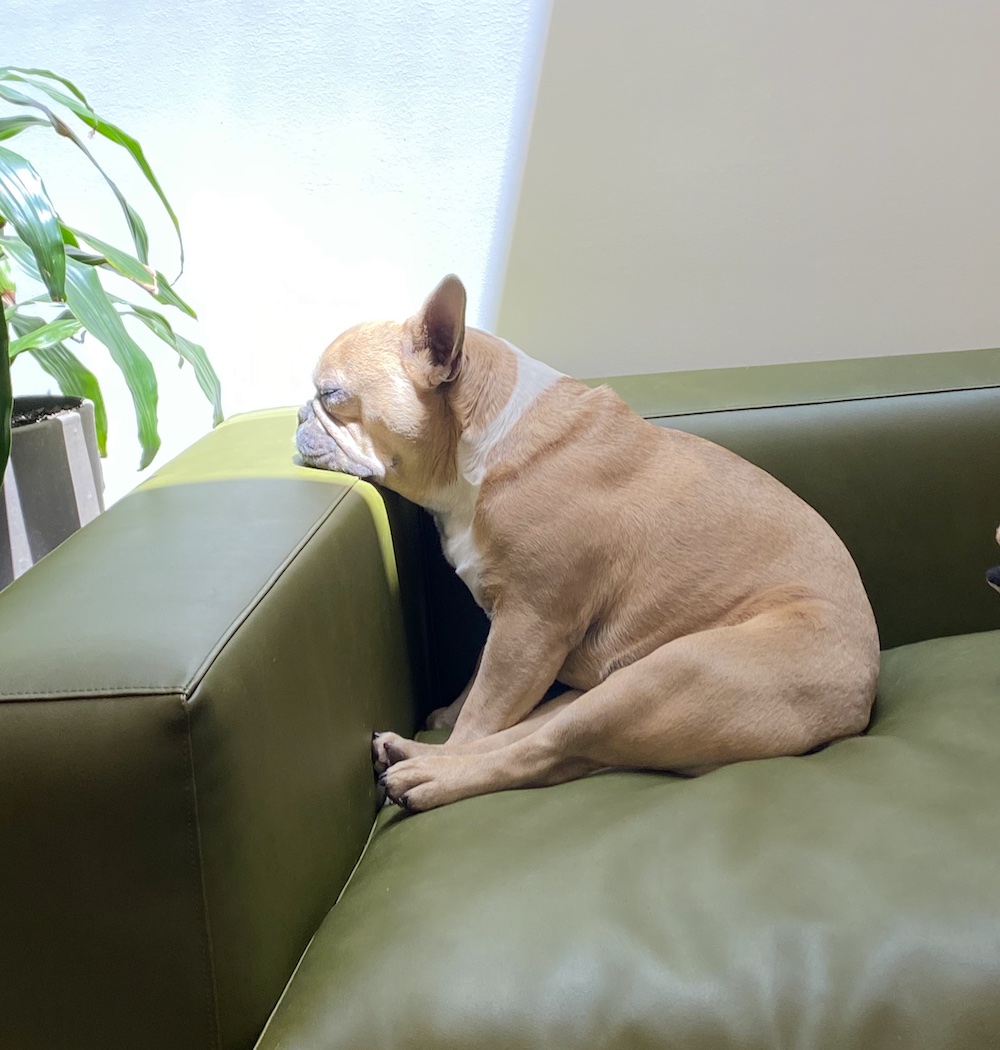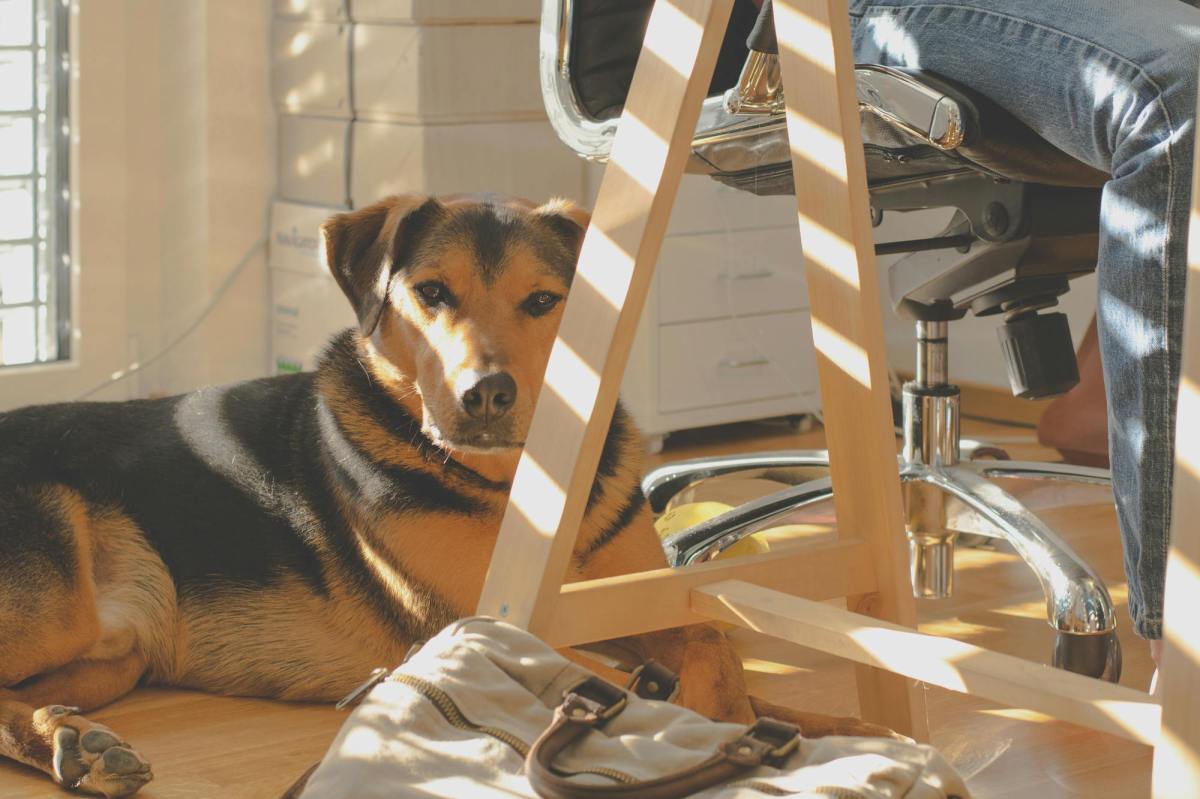Depending on who you ask last Friday 21 June or today (Monday 24 June) is international Take Your Dog to Work Day. Of course, for some, a special day is hardly merited as life with a pet is part of every single day.
The initiative was launched in 1999, but in a post-pandemic world, and with the rise of hybrid work environments, pets are playing a bigger role than ever.
COVID-19 proved that pets were good for our mental health, with dog ownership increasing by 10% during the pandemic. Now managers are recognising that allowing pets to co-reside in the office space can act as an incentive to entice employees back and leverage office time, says the Harvard Business Review.
Among the early leaders were tech companies in Silicon Valley. At Amazon, around 2000 dogs are regularly brought to work on the main campus, with Google and Apple also having pet-friendly policies in place for years.
With such numbers, obviously there are documented pros for a pet in the workplace. It has been said that it can lower stress levels, improve morale, encourage employee interaction and – the one we didn’t suspect – improve productivity.
In the cons camp, however, many people suffer allergies to animals and others experience fear and anxiety. ArtsHub takes a look at the shifting attitudes in the workplace today.
And in a follow-up article, we will take a deep dive into writing a pet policy for your workplace and offer a hot tips list for getting pet-friendly at work.
In this article:
How many pets are we talking about?
According to Dogster, there are almost 36 million pets in the UK. Out of all pet owners in Australia, 31% of them have dogs and 26% have a cat.
Dogster reports: ‘Despite this, the number of households owning at least one pet dropped from 62% in 2022 to 57% in 2023, likely as a result of changing work conditions and the cost-of-living crisis hitting a lot of households hard.’
We were unable to find research, however, on the percentage of those pets that accompany their owners to work. Today the demographic of pets at work is broad and it would seem, by the response to our callout to this story in Australia and Asia, is well-embraced by the arts.
Canvassing Facebook and social media on this trend, ArtsHub was flooded with personal stories (thank you!) – too many to share. What was consistent across all the messages was that these animals clearly had personalities in the workplace, and somewhat completed it for their owners.
‘I work for myself and my dog comes to work with me – like it’s his job too,’ Meaghan Shelton tells ArtsHub.
Artists’ studio dogs play a big role in that solitary pursuit. Many commercial galleries also have long had a dog as part of the gallery team, such as the Sydney galleries Dominik Mersch and Sarah Cottier, while artist Callum Morton recalls Crispin (Poodle) as being an integral part of the team at the Australian Centre for Contemporary Art (ACCA) in Melbourne, under Jenepher Duncan. ‘You could always hear the little clatter of her nails on the floorboards,’ says Morton.

The pros of a pet-inclusive workplace
‘Everyone seems to love the novelty of having a pet in the workplace,’ adds Lisa Cahill, Director Australian Design Centre in Sydney. Boo (Cavoodle) has been a part of the team for nine years, without complaint. Cahill says Boo’s presence, ‘makes for a more relaxing environment and is a good distraction sometimes from the pressures of work’.
It can mitigate burnout tendencies, which are related to higher stress and dissatisfaction, and increase the likelihood of turnover intention in the workplace.
Read: 7 signs of severe creative burnout
It is a view echoed by Megan Monte, Director of Ngununggula regional gallery in Australia. She says Vincent (Vinnie, French Bulldog) ‘adds to the welcoming environment we aim to have,’ noting that one of the benefits – apart from being good company – is that a pet in the workplace also ‘ensures you take a moment away to step outside.’
While Boo is not at work every day, Cahill says that all staff are consulted before making any decisions. She adds that a surprise advantage is that ‘Boo acts as a very efficient guard dog whenever anyone attempts entry to the office, particularly parcel delivery people’.
A further pro, as one paper says on the trend, is that ‘coming across as being dog-friendly is good press for companies,’ adding that ‘pet-friendly policies can project images of a relaxed culture and of informality, conveying a positive image to the outside world’.
Transparency is important
Gretel (Golden Retriever Labrador cross) is a breeder for Seeing Eye Dogs (SED). When Shanysa McConville started with the Museums and Collections team at the University of Melbourne, she flagged that she is a regular carer for SED breeders, and potentially their puppies.
‘As Gretel is a breeder for SED, she is allowed entry to all public spaces when in her working coat, which was understood by the team I joined,’ says McConville. ‘While Gretel thrives in “work mode” while in her working coat, she loves her free time to interact with my colleagues when she is out of her coat. I believe pets in the office more broadly boosts morale, ensures people take appropriate breaks (even just from sitting at their desks), and of course is beneficial for the pet’s socialisation.’
McConville adds: ‘There are some places that I opt to not bring Gretel (i.e. our collections store, because I am handling lots of objects that require my full attention).’
She concludes that while ‘lots of people enjoy seeing Gretel around the office, I think the best benefit is to Gretel herself, who absolutely loves interacting with people… Plus lunchtime leftovers never to go waste.’
Understand why – finding that purpose
Denzil, aka Denzidog, is an 11-year-old rescue Blue Heeler from Broken Hill/Wilyakali Country, and is the office dog of Artist Profile magazine – with a twist!
Publisher Kon Gouriotis tells ArtsHub: ‘When the idea of commissioning Denzidog as a reviewer for Artist Profile magazine was presented, it was met with a lot of smiles. Then there were the conversations around Denzidog’s most authentic voice being presented, without the Mister Ed (the talking horse) or scripted ghost text about art.
‘There was also the issue of who would assist Denzidog to visit the exhibitions. His carer, artist Justine Muller, was happy to help. After some discussions with Justine and Denzidog, the reviews would be staged with Denzidog photographed in front of his favourite artwork,’ says Gouriotis.
‘No one else would share that space with Denzidog, so there were no suggestions of a biased review,’ adds Muller. ‘He flies under the radar; no one suspects a dog is an art critic, so he gets lots of space to do his job.’ Denzidog’s reviews can be found on Artist Profile’s Instagram posts.
In another twist, Ella Dreyfus speaks of National Art School (Sydney) drawing lecturer Pam Vaughan’s dog Iggy, who used to join her class. ‘Students loved drawing him, he was so patient. Based on this success, we hired a Kindifarm and they set up outdoor pens with animals galore to draw!’ says Dreyfus.
What about the cons?
Understandably there are also reasonable challenges to the pet-inclusive workplace.
Chris Hunter reached out on Facebook and reminded ArtsHub that ‘there are many people with disabilities, more so health conditions, who would be greatly disadvantaged by having dogs in the workplace’.
‘It would be wonderful if everyone could have what they want, but often it disadvantages others,’ says Hunter.
The Asthma and Allergy Foundation of America suggests that an estimated 10 to 20% of people worldwide are allergic to dogs and cats. The threat of allergic reactions then is very real, if not among co-workers, then possibly from visitors to the workplace.
Hunter adds that some people suffer from hypersensitivity pneumonitis, and need to avoid animals, which would make visiting an organisation with a workplace dog difficult. A good example is artist and self-confessed dog-lover Lisa Anderson, who has a studio at Abbotsford Convent, where there are many office and studio dogs.
‘I have sadly developed a severe allergy to dogs – I love dogs but can’t go near them,’ she says, adding she has been hospitalised as a result. ‘It makes me sad that a lot of my world has closed down, as dogs are now in my local bar, café, restaurant, workplace … and soon, they say, on planes. For some humans, dogs are life threatening.’
Among the concerns, people’s genuine phobias (cynophobia), lesser fears and overall dislike of dogs should also be considered. Cynophobia is said to affect at least one in eight individuals in their lifetime, while another source pulls it back to one in 20.
Regardless of the frequency, the reality is that a dog in the workplace can increase stress – rather than alleviate it – for some people. ‘One person’s heaven may very well be another person’s hell,’ Hunter tells ArtsHub via Facebook.
Another report by the Harvard Business Review found that ‘a documented minority of employees view pet-friendly workplaces as unprofessional, unclean or unsafe,’ and that objections can also stem from cultural and religious traditions.
A further report on the growing trend points out that the practice may also be disruptive. ‘Dogs can be an extra responsibility for the owner, who needs to continuously keep the dog in mind. Some companies report problems with dogs stealing food, barking and behaving aggressively toward other dogs in the office, which forces owners to intervene and neglect their work assignments.’
According to Barker et al 20% of employees without dogs perceived dogs as reducing their personal productivity.
And what about cats?
While this story was triggered by Take Your Dog to Work Day’, ArtsHub also received lots of call-outs for cats.
‘I would go into the office more if we had a resident cat,’ says ArtsHub’s own Reviews and Literary Editor, Thuy On.
And a recent employee of Canberra Glassworks had an Assistance Rabbit, proving that anything is possible in the workplace with the correct approvals.
Accreditation or service pets in the workplace?
Several people in the sector reached out, saying that local governments and universities ban dogs in the workplace, unless they are an Accredited Assistance/Therapy Dog or Guide Dog. But others relayed positive experiences of pets in local council-run venues.
Accreditation and a policy seem to be the key here.
Artist and academic Callum Morton tells ArtsHub that he sometimes brings his dog in to Melbourne University where he teaches, ‘because she gives you that face when you are leaving home, so I take her on the grounds of “therapy”, because it stresses me out to think about that face all day. She often comes to the studio’.
Similarly, Hamish Ta-mé recalls that when working at Casula Powerhouse Arts Centre ‘there was an anonymous complaint and they had to develop a policy, which was essentially that the dog had to be a licensed support dog. Just calling it one was enough’.
Companion animals play an especially crucial role for some employees. Liza Gilbert works in the mental health unit at Five Islands Secondary College (FISC), in the Coastal Australian town of Port Kembla. The school’s learning environment is flexible, students don’t wear uniform, school hours are Monday to Thursday, individuality is valued, and there are two dogs on campus, she explains.
Gilbert tells ArtsHub: ‘I could not have imagined the reaction and positive impact that this little dog could have had on the mental health of our students, on social inclusion and the whole school community. Daisy (Shih Tzu) has had a profound effect on the lives and wellbeing of our students.’

She continues: ‘Daisy and I have undergone intensive training and assessment. With the Principal’s approval and the necessary paperwork (risk assessment, programs, vet checks etc), Daisy gained the status of FISC’s Therapy Dog.’
But it’s not necessary to be part of the special needs community to understand the health benefits animals can bring to such situations.
Eileen Legaspi-Ramirez, a lecturer at the University of Philippines Department of Art Studies, says that her 12-year-old Shih Tzu, Artz, ‘is a consistently calming presence across the board. He’s certainly that for me, and I sense that helps me engage with my students better’.
Legaspi-Ramirez says that it still isn’t a common policy in the Philippines to have pets in the workplace and concludes that ‘each doggo has a personality of its own’ and it is important to understand your dog’s temperament when considering whether or not to bring them to work.





